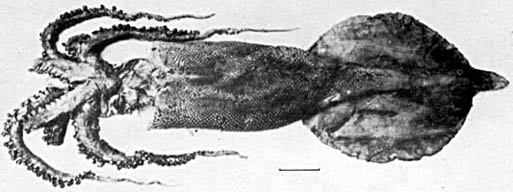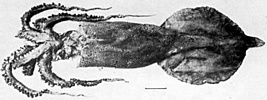Lepidoteuthidae
Lepidoteuthis grimaldii
The scaled squid
Richard E. Young and Michael VecchioneIntroduction
L. grimaldii is a large squid (100 cm ML) whose tentacles fail to grow much beyond the paralarval stage and are lost in subadults. It has a mantle mostly covered with overlapping dermal cushions (= "scales"). This squid is rarely captured and little is known of its biology.
Diagnosis
An oegopsid ...
- without tentacles.
- with biserial suckers on arms.
- with dermal cushions (scales) on mantle.
Characteristics
- Arms
- Arms with biserial suckers; single hook present near base of each arm II in males only (Jackson and O'Shea, 2003).
Figure. Oral views of a hook from arm II and adjacent sucker of L. grimaldii showing size comparison, xx mm ML, Male, Hawaiian waters. Outer horny ring and associated tissue removed. Photograph by R. Young.
Figure. Side views of the same hook and sucker from L. grimaldii. Photographs by R. Young.
- Arms with biserial suckers; single hook present near base of each arm II in males only (Jackson and O'Shea, 2003).
- Tentacles
- Tentacles absent in subadults and adults; greatly reduced in juveniles.
- Tentacles absent in subadults and adults; greatly reduced in juveniles.
- Mantle
- Fins
- Fins large, terminal.
- Fins large, terminal.
- Photophores
- Photophores absent.
Nomenclature
The paralarva was first described as Enoptroteuthis spinicauda Berry, 1920 but its familial relationships were obscure. Subsequently various authors placed it alternately in three different families. Over 70 years after its original capture, it was identified as belonging to none of these families, but as a young L. grimaldii (Young, 1991).
A list of all nominal genera and species in the Lepidoteuthidae can be found here. The list includes the current status and type species of all genera, and the current status, type repository and type locality of all species and all pertinent references.
Life History
The paralarva reaches a rather large size (at least 10 mm ML). Large, thick tentacles are present in the paralarva and they have small, compact clubs. The clubs carry only a few suckers, in two series, with some very large and some very small. During the early subadult stage, the tentacles are lost. The adults therefore rely solely on their eight arms for capturing prey. Young et al. (1998) suggest that the ancestor of Lepidoteuthis may have had highly specialized, elongate tentacles, as are found in some chiroteuthidids today. When evolutionary pressures changed, the tentacles were too specialized to change quickly and, instead, were lost.
 image info
image info  image info
image info  image info
image info
Figure. Left - Ventral views of tentacular club, brachial crown and paralarva of L. grimaldii, 10 mm ML, off Hawaii. The digestive gland is bright red and spindle-shaped, although it appears round in ventral view, and is located well posterior to the cephalic cartilage. Photographs from Young, et al. (1998). Right - Ventral view of a paralarva of L. grimaldii and an oral view of its tentacular club, 9.7 mm ML. Note the terminal position of the fins. Drawing from Young, 1991.
Distribution
This species is known from the tropical and subtropical of the regions of the Atlantic, Pacific and Indian Oceans (Nesis, 1982/87).
References
Berry, S. S. 1920. Preliminary diagnoses of new cephalopods from the western Atlantic. Proc. U.S. Nat. Mus. 58: 293-300.
Clarke, M. R. 1964. Young stages of Lepidoteuthis grimaldii (Cephalopoda, Decapoda). Proc. Malac. Soc. Lond., 36: 69-78.
Clarke, M. R. and G. E. Maul. 1962. A description of the "scaled" squid Lepidoteuthis grimaldi Joubin 1895. Proc. Zool. Soc. Lond., 139: 97-118.
Nesis, K. N. 1982/87. Abridged key to the cephalopod mollusks of the world's ocean. 385+ii pp. Light and Food Industry Publishing House, Moscow. (In Russian.). Translated into English by B. S. Levitov, ed. by L. A. Burgess (1987), Cephalopods of the world. T. F. H. Publications, Neptune City, NJ, 351pp.
Young, R. E. (1991). Chiroteuthid and related paralarvae from Hawaiian waters. Bull. Mar. Sci., 49: 162-185.
Young, R. E., M. Vecchione and D. Donovan. 1998. The evolution of coleoid cephalopods and their present biodiversity and ecology. South African Jour. Mar. Sci., 20: 393-420.
Title Illustrations
| Scientific Name | Lepidoteuthis grimaldii |
|---|---|
| Reference | from Clarke, M. R. and G. E. Maul. 1962. A description of the "scaled" squid Lepidoteuthis grimaldi Joubin 1895. Proc. Zool. Soc. Lond. 139:97-118. |
| Life Cycle Stage | adult |
| View | ventral |
| Size | 75 cm ML |
About This Page
Richard E. Young
Dept of Oceanography
University of Hawaii
Honolulu, Hawaii 96822
USA
National Marine Fisheries Service
Systematics Laboratory
National Museum of Natural History
Washington, D. C. 20560
USA
Page copyright © 1998 Richard E. Young
Citing this page:
Young, Richard E. and Vecchione, Michael. 1998. Lepidoteuthidae . Lepidoteuthis grimaldii . The scaled squid. Version 01 January 1998 (under construction). http://tolweb.org/Lepidoteuthis_grimaldii/19833/1998.01.01 in The Tree of Life Web Project, http://tolweb.org/













